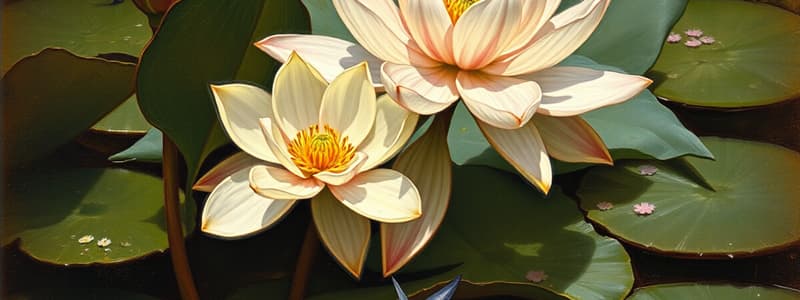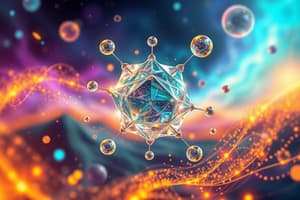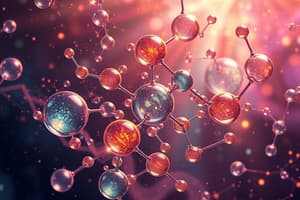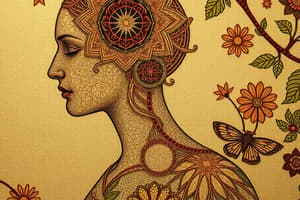Podcast
Questions and Answers
A substance that cannot be broken down into other substances by ordinary chemical procedures is a(n) _____.
A substance that cannot be broken down into other substances by ordinary chemical procedures is a(n) _____.
element
What is the charge of a proton?
What is the charge of a proton?
+1 charge
What is the charge of a neutron?
What is the charge of a neutron?
0 charge
What is the charge of an electron?
What is the charge of an electron?
Mass of ~1 amu is associated with a _____ or a _____.
Mass of ~1 amu is associated with a _____ or a _____.
Mass of ~1/2000 amu corresponds to an _____ .
Mass of ~1/2000 amu corresponds to an _____ .
What is the mass number of an ion with 104 electrons, 158 neutrons, and a +1 charge?
What is the mass number of an ion with 104 electrons, 158 neutrons, and a +1 charge?
The innermost electron shell of an atom can hold up to _____ electrons.
The innermost electron shell of an atom can hold up to _____ electrons.
Which of these relationships is true of an uncharged atom?
Which of these relationships is true of an uncharged atom?
What determines the types of chemical reactions that an atom participates in?
What determines the types of chemical reactions that an atom participates in?
What is the atomic number of an atom that has 6 protons, 6 neutrons, and 6 electrons?
What is the atomic number of an atom that has 6 protons, 6 neutrons, and 6 electrons?
Which of these refers to atoms with the same atomic number but different atomic masses?
Which of these refers to atoms with the same atomic number but different atomic masses?
Fluorine's atomic number is 9 and its atomic mass is 19. How many neutrons does fluorine have?
Fluorine's atomic number is 9 and its atomic mass is 19. How many neutrons does fluorine have?
An uncharged atom of boron has an atomic number of 5 and an atomic mass of 11. How many protons does boron have?
An uncharged atom of boron has an atomic number of 5 and an atomic mass of 11. How many protons does boron have?
Changing the number of _____ would change an atom into an atom of a different element.
Changing the number of _____ would change an atom into an atom of a different element.
The atoms of different phosphorus isotopes _____.
The atoms of different phosphorus isotopes _____.
The type of bonding and the numbers of covalent bonds an atom can form with other atoms is determined by _____ .
The type of bonding and the numbers of covalent bonds an atom can form with other atoms is determined by _____ .
What type of bond is joining the two hydrogen atoms?
What type of bond is joining the two hydrogen atoms?
A(n) _____ refers to two or more atoms held together by covalent bonds.
A(n) _____ refers to two or more atoms held together by covalent bonds.
This atom can form up to _____ single covalent bond(s).
This atom can form up to _____ single covalent bond(s).
A(n) _____ bond joins these two oxygen atoms.
A(n) _____ bond joins these two oxygen atoms.
Atoms with the same number of protons but with different electrical charges _____.
Atoms with the same number of protons but with different electrical charges _____.
In salt, what is the nature of the bond between sodium and chlorine?
In salt, what is the nature of the bond between sodium and chlorine?
What is the result of the animated process?
What is the result of the animated process?
An ionic bond involves _____.
An ionic bond involves _____.
What type of bond joins the carbon atom to each of the hydrogen atoms?
What type of bond joins the carbon atom to each of the hydrogen atoms?
The brackets are indicating a(n) _____ bond.
The brackets are indicating a(n) _____ bond.
What name is given to the bond between water molecules?
What name is given to the bond between water molecules?
A carbon atom and a hydrogen atom form what type of bond in a molecule?
A carbon atom and a hydrogen atom form what type of bond in a molecule?
An ionic bond is formed when _____ .
An ionic bond is formed when _____ .
Chemical equilibrium is reached when _____.
Chemical equilibrium is reached when _____.
What does the term electron orbital describe?
What does the term electron orbital describe?
What happens when two atoms form a chemical bond?
What happens when two atoms form a chemical bond?
Which statement about weak bonds is correct?
Which statement about weak bonds is correct?
Study Notes
Atoms and Elements
- An element is a fundamental substance that cannot be broken down into simpler substances through chemical means.
- Protons carry a positive charge (+1) and are denoted by the symbol p.
- Neutrons have no charge (0) and are represented by the symbol n.
- Electrons possess a negative charge (-1) and use the symbol e.
Atomic Mass and Structure
- Protons and neutrons each have a mass of approximately 1 atomic mass unit (amu).
- Electrons have a negligible mass, approximately 1/2000 amu.
- The mass number for an ion with 104 electrons, 158 neutrons, and a +1 charge is 263.
- The innermost electron shell of an atom can accommodate a maximum of 2 electrons.
Charged Atoms and Isotopes
- An uncharged atom contains an equal number of protons and electrons.
- The atomic number of an atom with 6 protons, 6 neutrons, and 6 electrons is 6.
- Atoms with the same atomic number but different atomic masses are known as isotopes.
- Fluorine, with an atomic number of 9 and atomic mass of 19, has 10 neutrons.
Electron Configuration
- An uncharged atom of boron, with an atomic number of 5 and atomic mass of 11, has 5 protons.
- Changing the number of protons in an atom transforms it into a different element.
- Different isotopes of phosphorus have varying numbers of neutrons.
Chemical Bonding
- The nature of bonding and the number of covalent bonds an atom can form depend on the number of unpaired electrons in the valence shell.
- A bond joining two hydrogen atoms is a covalent bond.
- A molecule is formed when two or more atoms are held together by covalent bonds.
- Carbon can form up to 4 single covalent bonds.
- A double covalent bond occurs between two oxygen atoms.
Ionic Bonds
- Atoms with the same number of protons but different electrical charges are classified as ions.
- In sodium chloride (salt), the bond between sodium and chlorine is ionic.
- The result of interactions in salt formation is a positively charged sodium ion and a negatively charged chlorine ion.
- An ionic bond arises from the attraction between ions of opposite charges.
Types of Bonds in Molecules
- Carbon and hydrogen form a single (nonpolar) covalent bond.
- Hydrogen bonds, indicated by brackets, label interactions between molecules like water.
- The bond between water molecules is also a hydrogen bond.
- An ionic bond occurs when one atom transfers an electron to another.
Chemical Equilibrium and Electron Orbitals
- Chemical equilibrium is established when forward and reverse reactions take place at the same rate, maintaining constant reactant and product concentrations.
- An electron orbital describes the three-dimensional region where an electron is likely to be found 90% of the time.
- A chemical bond forms when two atoms either transfer or share outer electrons to complete their valence shells.
Characteristics of Weak Bonds
- Weak bonds are typically transient and easily reversible, allowing for dynamic interactions in molecular biology.
Studying That Suits You
Use AI to generate personalized quizzes and flashcards to suit your learning preferences.
Description
Test your knowledge of key terms and concepts from Chapter 2 of Mastering Biology. This quiz covers essential definitions and symbols associated with fundamental biological elements. Perfect for reinforcing your understanding of basic biology concepts.




